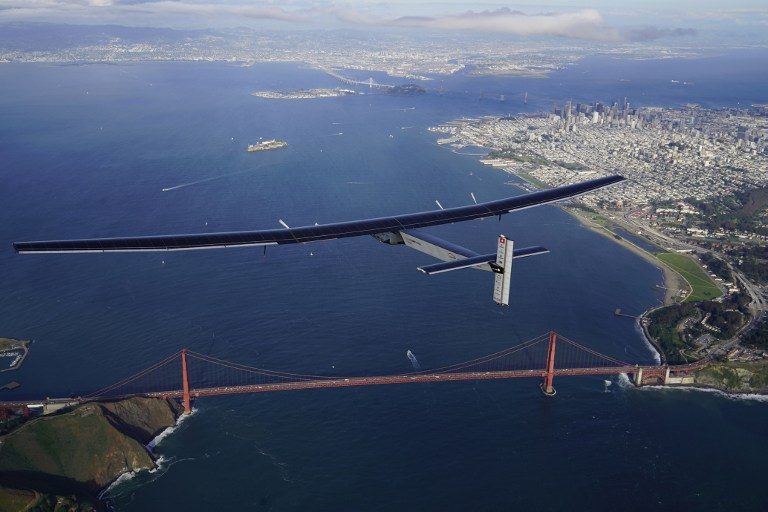SUMMARY
This is AI generated summarization, which may have errors. For context, always refer to the full article.

SAN FRANCISCO, USA (4th UPDATE) – The Solar Impulse 2, an experimental aircraft flying around the world to draw attention to clean energy technologies, soared over the US Mojave Desert Monday, May 2, en route to the southwest city of Phoenix.
Pilot Andre Borschberg took to the air from Moffett Airfield southeast of San Francisco just after 5:00 am (1200 GMT) on what is expected to be a more than 16-hour journey.
The plane had been in California for a week since crossing the Pacific in an approximately 60-hour flight to land in Mountain View.
Borschberg, who has been alternating the long solo flights with his teammate, Swiss adventurer Bertrand Piccard, will pilot Solar Impulse across the United States and to New York. Piccard piloted the craft from Hawaii to California.
“The sun is rising in the horizon. It feels good to be flying round-the-world with #Si2 again,” Borschberg posted on Twitter.
The 63-year-old adventurer took off at the early hour to take advantage of a clear weather window as he flies to Phoenix Goodyear Airport in Arizona, crossing some 720 miles (1,160 kilometers) over the Mojave Desert.
The takeoff marked the beginning of the 10th of 13 legs in a journey that began last year in the United Arab Emirates.
“As the sun gets higher, #Si2’s energy reserves will start filling up, thanks to all its #cleantechs,” Borschberg wrote on Twitter.
The solar-powered plane, which stores energy in batteries for when the sun is not shining, will make several stops across the United States, although the team is still examining potential destinations.
Thanks to an inflatable mobile hangar, which can be packed up quickly and transported, Solar Impulse 2 can be sheltered at a variety of possible locations.
The plane will make a final US stop in New York before a transatlantic flight to Europe. From there, the pilots plan to make their way back to the point of departure in Abu Dhabi.
Technologies useable ‘on ground’
The mission aims to promote the use of renewable energy, with an aircraft powered by 17,000 solar cells.
“If an airplane can fly day and night without fuel, we could all use these same clean technologies on the ground to develop new industrial markets and stimulate economic growth, while also protecting the environment,” Piccard said in a statement.
The plane’s wingspan is wider than that of a jumbo jet but its weight is roughly the same as a family car.
Solar Impulse 2 was grounded in July last year when its batteries suffered problems halfway through its 21,700-mile (35,000-kilometer) circumnavigation.
The crew took several months to repair damage from tropical high temperatures during the first Pacific stage, a 4,000-mile flight between Japan and Hawaii.
The aircraft was flown on that leg by Borschberg, whose 118-hour journey smashed the previous record of 76 hours and 45 minutes set by US adventurer Steve Fossett in 2006.
Born in Zurich, Borschberg is no stranger to adventure – 15 years ago he narrowly escaped an avalanche, and then in 2013 he escaped a helicopter crash with just minor injuries.
He took catnaps of only 20 minutes at a time to maintain control of the pioneering plane during his arduous flight from Japan, in what his team described as “difficult” conditions.
Piccard, a 58-year-old doctor by training, already completed the first non-stop round-the-world balloon flight in 1999. – Rappler.com
Add a comment
How does this make you feel?
There are no comments yet. Add your comment to start the conversation.